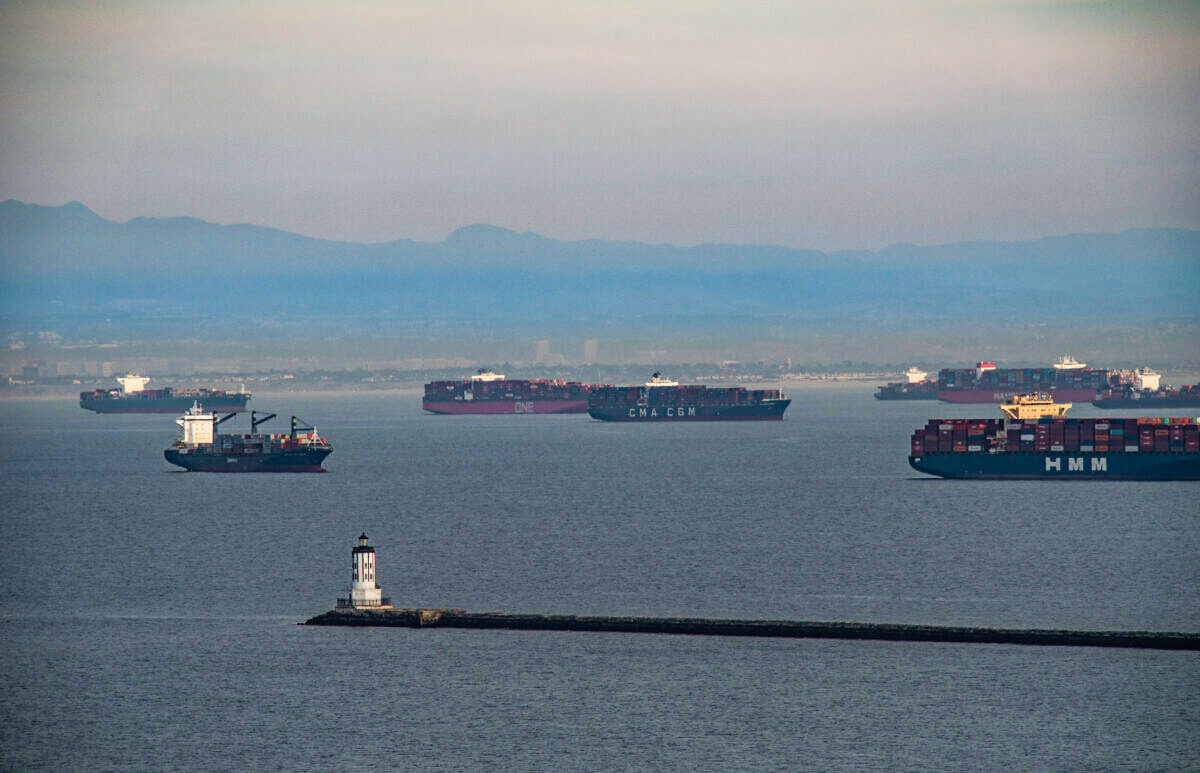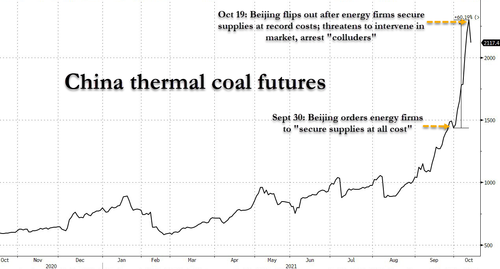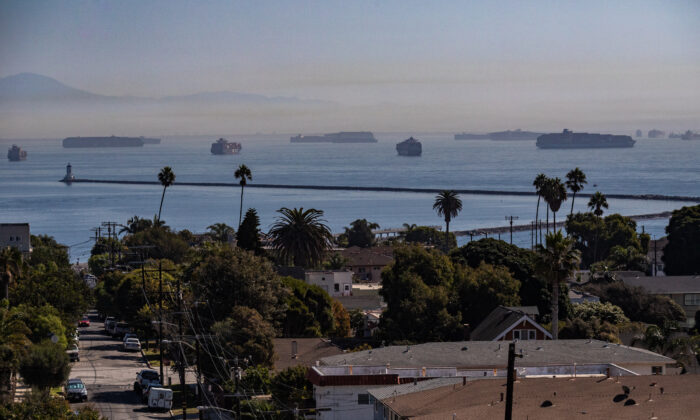Epoxy
October 21, 2021
Olin Shutting Down More Chlor Alkali Capacity
http://www.olin.com/investors/events-presentations/press-releases/
October 20, 2021
Port Update
Ships await to enter the ports of Los Angeles and Long Beach on Oct. 14, 2021. (John Fredricks/The Epoch Times) Economy
Record Number of Container Ships Waiting Off Ports of Long Beach, Los Angeles: Executive
By Jack Phillips October 19, 2021 Updated: October 19, 2021 biggersmallerPrint
The United States’ largest container port now has a record backlog of ships and containers, according to Gene Seroka, the executive director of the Port of Los Angeles.
“We have about two weeks’ worth of work sitting at anchor right now,” Seroka told CNN, adding that port workers are currently trying to prioritize the cargo that needs to move from the port as soon as possible.
Some 200,000 shipping containers remain on ships off the coast, he added.
“There’s product that needs to get out there in super-fast speed,” he said. “Think about the toys, the other Christmas product, and parts and components for factories.”
His comment comes just days after President Joe Biden announced that the Ports of Los Angeles and Long Beach have committed to 24/7 shifts to alleviate supply chain bottlenecks ahead of the Christmas shopping season. The White House also said it secured agreements with UPS, Walmart, and FedEx to increase the number of shifts.
“We had 25 percent of all cargo on our dock sitting here for 13 days or longer [and] that’s been cut in just about half over the last week,” Seroka said.

Phillip Sanfield, director of media relations for the port, noted that although the Port of Los Angeles now operates on a 24/7 schedule, its terminals remain closed between 3 a.m. and 8 a.m. The terminals are privately owned and operated.
“Currently there seems to be no cargo owners who are looking to use the 3 am. to 8 a.m. window,” he told CNN. “Terminals don’t want to be open if there is no interest in using the gates. We’re not yet seeing demand by cargo owners to come get their cargo during the overnight hours.”
“The Port of LA is ready now. We have plenty of longshore workers. The issue is truckers and more importantly, cargo to be picked up,” he added. “We’re working with importers, terminals, etc. to get a demand for that window. There’s no one single lever to pull.”
Meanwhile, Danielle Inman, a spokesperson for the National Retail Foundation, told Politifact that Assembly Bill 5—which critics have said triggered a wave of owner-operator truckers and trucking fleets to stop doing business in California—may be part of the issue why there’s a shipping backlog at the ports. However, she stressed it’s not the only reason.
“The overwhelming increase in volume, lack of available equipment such as chassis, empty container return policies, lack of available warehouse space are all contributing to the ongoing congestion issues at the ports,” Inman told the website.
October 20, 2021
Port Update
Ships await to enter the ports of Los Angeles and Long Beach on Oct. 14, 2021. (John Fredricks/The Epoch Times) Economy
Record Number of Container Ships Waiting Off Ports of Long Beach, Los Angeles: Executive
By Jack Phillips October 19, 2021 Updated: October 19, 2021 biggersmallerPrint
The United States’ largest container port now has a record backlog of ships and containers, according to Gene Seroka, the executive director of the Port of Los Angeles.
“We have about two weeks’ worth of work sitting at anchor right now,” Seroka told CNN, adding that port workers are currently trying to prioritize the cargo that needs to move from the port as soon as possible.
Some 200,000 shipping containers remain on ships off the coast, he added.
“There’s product that needs to get out there in super-fast speed,” he said. “Think about the toys, the other Christmas product, and parts and components for factories.”
His comment comes just days after President Joe Biden announced that the Ports of Los Angeles and Long Beach have committed to 24/7 shifts to alleviate supply chain bottlenecks ahead of the Christmas shopping season. The White House also said it secured agreements with UPS, Walmart, and FedEx to increase the number of shifts.
“We had 25 percent of all cargo on our dock sitting here for 13 days or longer [and] that’s been cut in just about half over the last week,” Seroka said.

Phillip Sanfield, director of media relations for the port, noted that although the Port of Los Angeles now operates on a 24/7 schedule, its terminals remain closed between 3 a.m. and 8 a.m. The terminals are privately owned and operated.
“Currently there seems to be no cargo owners who are looking to use the 3 am. to 8 a.m. window,” he told CNN. “Terminals don’t want to be open if there is no interest in using the gates. We’re not yet seeing demand by cargo owners to come get their cargo during the overnight hours.”
“The Port of LA is ready now. We have plenty of longshore workers. The issue is truckers and more importantly, cargo to be picked up,” he added. “We’re working with importers, terminals, etc. to get a demand for that window. There’s no one single lever to pull.”
Meanwhile, Danielle Inman, a spokesperson for the National Retail Foundation, told Politifact that Assembly Bill 5—which critics have said triggered a wave of owner-operator truckers and trucking fleets to stop doing business in California—may be part of the issue why there’s a shipping backlog at the ports. However, she stressed it’s not the only reason.
“The overwhelming increase in volume, lack of available equipment such as chassis, empty container return policies, lack of available warehouse space are all contributing to the ongoing congestion issues at the ports,” Inman told the website.
October 19, 2021
China Coal
China Jawbones Coal Markets With Meaningless “Market Intervention” Headlines As It Becomes Desperate
by Tyler DurdenTuesday, Oct 19, 2021 – 05:45 PM
What’s wrong with communism? The latest example comes from China, where central planners told state-owned energy companies to panic buy coal which sent prices to the moon. Now the communist government is battling market forces with meaningless headlines to jawbone prices lower.
Just as thermal coal futures on the Zhengzhou Commodity Exchange catapulted to new heights, the National Development and Reform Commission (NDRC), China’s top economic planner, announced in the Tuesday overnight Asian session that it has a plan to intervene in coal markets to halt the rally, according to Bloomberg.

The headlines were empty and meaningless. It may suggest that Beijing is running out of options to stymie the price rally ahead of the Northern Hemisphere winter, where national stockpiles of fossil fuels are at extremely low seasonal levels. NDRC said it would examine various measures to intervene in markets. It said it had a “zero tolerance” for market participants spreading fake news or conspiring with others to push prices higher.
Here’s NDRC’s most desperate headline:
“The current price increase has completely deviated from the fundamentals of supply and demand,” NDRC said in a statement published on WeChat.
Seriously? The reason prices are sky-high is because of supply and demand dynamics. The agency went on to say it “will study-specific measures to intervene in coal prices and promote the return of coal prices to a reasonable range,” adding that it would increase coal output to 12 million per day and give coal transportation through ports and railroads the highest priority.
Beijing even sent Vice Premier Han Zheng on China National Radio Tuesday to praise the “powerful measures to curb speculation and hoarding in energy markets.” Still, we have no idea how the communist government plans to intervene in markets – just jawboning markets at this point.
What caused the latest leg up in coal prices was when Beijing’s state-asset regulator last month ordered state-owned energy companies to acquire coal supplies at all costs. This forced coal prices higher and resulted in more power blackouts across the country.
China derives 50% of its power from coal. If prices continue to rise, local authorities will have to continue shutting down energy-intensive industries to protect the grid. In return, this will weigh on not just the domestic economy but also the global economy.
Central planners have already told state-owned mines in Yulin, a major coal hub in Shaanxi province, to reduce coal prices by 100 yuan per ton less than spot.
An analyst with Daiwa Capital Markets told clients in a note that favorable supply and demand dynamics suggest elevated coal prices will remain through winter. More or less, whatever Beijing has up its sleeves, could be uneventful in reigning in coal prices back to normal levels.
China has also taken additional steps to alleviate the energy crunch by allowing coal-fired power prices to fluctuate by up to 20%, enabling power plants to pass on more of the high costs of generation to commercial and industrial end-users.
The bottom line is that Beijing is throwing the proverbial “kitchen sink” to reign in coal prices with meaningless statements that may fail to arrest prices in the months ahead as supply and demand dynamics show central planning is the wrong way to manage an economy.
https://www.zerohedge.com/commodities/coal-prices-drop-beijing-studies-market-interventions
October 19, 2021
China Coal
China Jawbones Coal Markets With Meaningless “Market Intervention” Headlines As It Becomes Desperate
by Tyler DurdenTuesday, Oct 19, 2021 – 05:45 PM
What’s wrong with communism? The latest example comes from China, where central planners told state-owned energy companies to panic buy coal which sent prices to the moon. Now the communist government is battling market forces with meaningless headlines to jawbone prices lower.
Just as thermal coal futures on the Zhengzhou Commodity Exchange catapulted to new heights, the National Development and Reform Commission (NDRC), China’s top economic planner, announced in the Tuesday overnight Asian session that it has a plan to intervene in coal markets to halt the rally, according to Bloomberg.

The headlines were empty and meaningless. It may suggest that Beijing is running out of options to stymie the price rally ahead of the Northern Hemisphere winter, where national stockpiles of fossil fuels are at extremely low seasonal levels. NDRC said it would examine various measures to intervene in markets. It said it had a “zero tolerance” for market participants spreading fake news or conspiring with others to push prices higher.
Here’s NDRC’s most desperate headline:
“The current price increase has completely deviated from the fundamentals of supply and demand,” NDRC said in a statement published on WeChat.
Seriously? The reason prices are sky-high is because of supply and demand dynamics. The agency went on to say it “will study-specific measures to intervene in coal prices and promote the return of coal prices to a reasonable range,” adding that it would increase coal output to 12 million per day and give coal transportation through ports and railroads the highest priority.
Beijing even sent Vice Premier Han Zheng on China National Radio Tuesday to praise the “powerful measures to curb speculation and hoarding in energy markets.” Still, we have no idea how the communist government plans to intervene in markets – just jawboning markets at this point.
What caused the latest leg up in coal prices was when Beijing’s state-asset regulator last month ordered state-owned energy companies to acquire coal supplies at all costs. This forced coal prices higher and resulted in more power blackouts across the country.
China derives 50% of its power from coal. If prices continue to rise, local authorities will have to continue shutting down energy-intensive industries to protect the grid. In return, this will weigh on not just the domestic economy but also the global economy.
Central planners have already told state-owned mines in Yulin, a major coal hub in Shaanxi province, to reduce coal prices by 100 yuan per ton less than spot.
An analyst with Daiwa Capital Markets told clients in a note that favorable supply and demand dynamics suggest elevated coal prices will remain through winter. More or less, whatever Beijing has up its sleeves, could be uneventful in reigning in coal prices back to normal levels.
China has also taken additional steps to alleviate the energy crunch by allowing coal-fired power prices to fluctuate by up to 20%, enabling power plants to pass on more of the high costs of generation to commercial and industrial end-users.
The bottom line is that Beijing is throwing the proverbial “kitchen sink” to reign in coal prices with meaningless statements that may fail to arrest prices in the months ahead as supply and demand dynamics show central planning is the wrong way to manage an economy.
https://www.zerohedge.com/commodities/coal-prices-drop-beijing-studies-market-interventions
